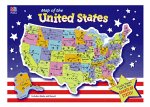United States Map Puzzle
Map of the United States 84-piece Jigsaw Puzzle.
 This 84-piece jigsaw puzzle assembles into the 48 contiguous United States, plus Alaska and Hawaii. The pieces are large enough to be safe for curious little ones and make for a fun and truly hands-on lesson in geography. The mapping is detailed enough to highlight major cities and towns, as well as rivers and some topography. To test your smarts, try constructing it without the benefit of a map. Along about fourth or fifth grade, students in the U.S. are expected to memorize all of the states, their locations, and their capital cities. If you can manage to get a jump-start on this very necessary chunk of information, so much the better for your child: it will be easier for them to learn later, and there's a much greater chance of permanent retention. This is where puzzles and card games can be really helpful, especially if they're well designed.
This 84-piece jigsaw puzzle assembles into the 48 contiguous United States, plus Alaska and Hawaii. The pieces are large enough to be safe for curious little ones and make for a fun and truly hands-on lesson in geography. The mapping is detailed enough to highlight major cities and towns, as well as rivers and some topography. To test your smarts, try constructing it without the benefit of a map. Along about fourth or fifth grade, students in the U.S. are expected to memorize all of the states, their locations, and their capital cities. If you can manage to get a jump-start on this very necessary chunk of information, so much the better for your child: it will be easier for them to learn later, and there's a much greater chance of permanent retention. This is where puzzles and card games can be really helpful, especially if they're well designed.
Milton Bradley's United States puzzle has much to recommend it: it's inexpensive, for one thing, the pieces are large and easy to manage (average size is about 2 by 2 inches), and it contains an awful lot of information. Latitude and longitude lines, major products and industries, and of course major cities and capitals are all represented in simple graphics. Except for a few of the tiny Atlantic seaboard states, puzzle pieces are actually cut along state borders--giving kids a handle on their individual geographical shape. A border of interlocking puzzle pieces keeps them in their proper places. The second grader who enjoys puzzles will learn a great deal just by putting it together a few times; older children--especially hands-on and visual learners--will have a lot more fun acquiring the facts with a puzzle than by desperately (and temporarily) memorizing them the night before a test.
Map puzzles serve as an interactive and engaging way to introduce children to geography. As they piece together regions, countries, or states, kids inherently learn about borders, landmarks, and spatial relations. Unlike passive learning from a book or screen, the tactile nature of a puzzle helps to reinforce memory and retention. The activity also fosters problem-solving skills as children figure out where each piece fits in relation to the others. Additionally, map puzzles often come with labels for cities, rivers, mountains, and other geographical features, thereby enriching vocabulary and general knowledge. They offer a hands-on experience that not only teaches children about the world they live in but also promotes cognitive and motor skills, making them an excellent educational tool.
